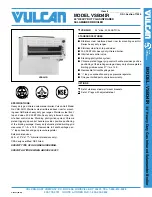
10
• The temperature and pressure relief valve should be checked to ensure that it is in operating condition. To
check the relief valve, lift the lever at the end of the valve several times. The valve should seat properly and
operate freely. If water does not flow, remove and inspect for obstructions or corrosion. Replace with a new
valve of the recommended capacity as necessary. Do not attempt to repair the valve, as this could result in
improper operation and a tank explosion. In areas with poor water conditions, it may be necessary to inspect
the temperature and pressure relief valve more often than once a year.
Before manually operating the valve, make sure that a drain line has been attached to the valve to direct the dis-
charge to an open drain. Failure to take this precaution could mean contact with extremely hot water discharging
from the valve during this checking operation.
If the temperature and pressure relief valve on the heater discharges periodically or continuously, it may be due
to thermal expansion of water in a closed water supply system, or it may be due to a faulty relief valve. Thermal
expansion is the normal response of water when it is heated. In a closed system, thermal expansion will cause the
system pressure to build until the relief valve actuation pressure is equaled. Then the relief valve will open, allow-
ing some water to escape, slightly lowering the pressure. Contact your water supplier or local plumbing inspector
on how to control this situation.
3.
Sediment (Annual except where harsh water quality may require more frequent service)
Depending on water conditions, a varying amount of sediment may collect in the tank. Repeated flushing usu-
ally clears such material. As a preventive measure, water should be drawn from the drain valve until it runs
clear and the installation of a water filter should be considered.
4.
Inspect Anode (annual)
• The purpose of the magnesium anode is to reduce the damaging effects of aggressive water on the water
heater. Aggressive water will cause the anode(s) to erode. The anode(s) must be inspected at least annually
to determine whether a new anode should be installed. Use anode replacement parts supplied by ECR only.
ECR anodes are 1-1/4 NPT and are made with magnesium, brass, and stainless steel. There is no steel in a
ECR anode. Severe or rapid deterioration of the anode indicates very aggressive water. If this occurs, have the
water tested to verify whether it is within the limits outlined on page 3. Failure to inspect the anode regularly
and replace if necessary could result in damage to the water heater. If this unit is installed and maintained ac-
cording to the instructions and conditions in this manual, this product will last for a long time.
1.
Close domestic water isolation valves.
2.
Drain the water heater completely and allow it to cool off.
3.
Remove the anode cover on the front of the unit. See figures on pages 5. The temperature control can be
turned to the side to allow easier access.
4.
After the water heater has drained and cooled, remove the anode using a 1¾” 6-point socket and a
breaker bar.
5.
Inspect the anode and replace if needed. The anode should be replaced when more than 6” of core wire is
exposed. The anode should be replaced with a ECR supplied anode only. See above. The brass hex on the
anode is 1¼ NPT and installs into a 1¼ stainless half coupling on the shell of the tank. This part will need
to be properly Teflon taped and coated with a quality Teflon based pipe sealant.
6.
Replace the inspection cover.
7.
Refill the water heater, and restore to operation.
8.
Verify operation of the water heater.
NOTICE


































